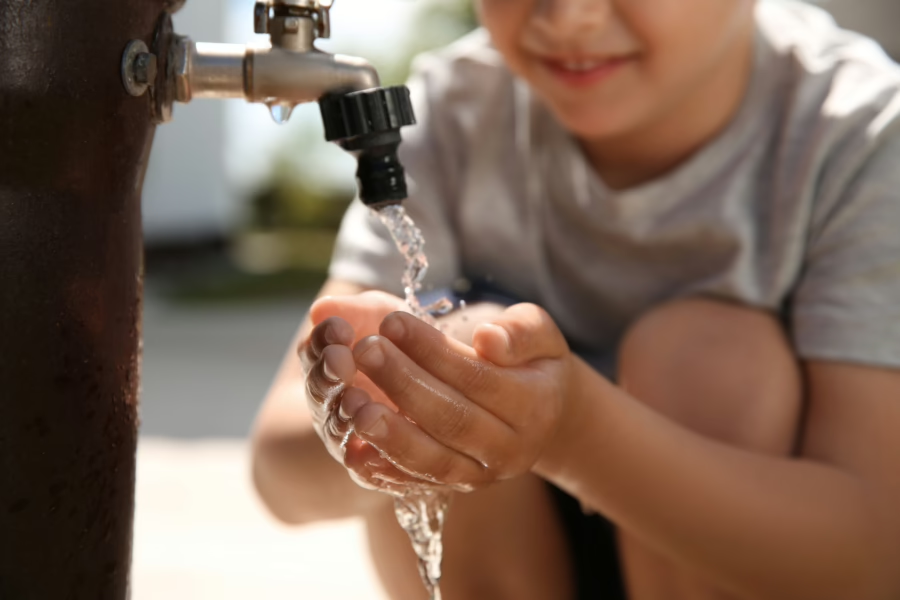Joshua Tree is an unincorporated community in San Bernadino County, CA, adjacent to Joshua Tree National Park in the state’s high desert. Most governmental services in Joshua Tree are provided by the County—except for drinking water, which is provided by a local public agency: The Joshua Basin Water District (JBWD). JBWD was formed in 1963 and is governed by an elected board of directors, making it the only public entity in the area that has elected representation.

Image courtesy of Caroline Gutman
Covering 96 square miles of arid desert terrain, JBWD’s service area is expansive, yet it serves only about 7,400 people. (For comparison, this is about the same area as the City of Milwaukee, which is home to approximately 560,000 people.) To meet the needs of such a large service area, JBWD owns and operates a tremendous amount of infrastructure, including five wells, 17 reservoir tanks, recharge ponds, and approximately 300 miles of pipelines.
We—the US Water Alliance’s technical assistance team—were connected with JBWD in early 2024. JBWD is facing compounding issues that make it a strong candidate for technical assistance support. Specifically, the District’s infrastructure is aging, it has a small, dispersed, and rural customer base, and it is facing a new regulatory requirement related to hexavalent chromium that will require the utility to study, design, construct, and operate a new drinking water treatment facility. Their customer base, a mix of rental properties and primary homeowners, already feels rate pressure. Thus, JBWD will need support to get the project fully funded.
To help meet JBWD’s technical needs, we are taking a two-pronged assistance approach. First, we connected JBWD with the subconsultant engineering consulting firm, Jacobs. Jacobs and JBWD are working together to conduct an alternatives analysis for hexavalent chromium treatment, evaluating different means of drawing and treating source water relative to JBWD’s priorities (e.g., capital cost, system dynamics, etc.). At the conclusion of the hexavalent chromium study, JBWD will have a better understanding of the most suitable treatment option for their conditions, and the Alliance team will transition to working with JBWD to identify state and federal funding options that could be appropriate for their project and engaging the community on the proposed treatment strategy.

Image courtesy of Caroline Gutman
The second part of this approach is supporting JBWD with community engagement, given the significant communications responsibilities the utility faces. The treatment project will be costly and will inevitably have rate implications. Additionally, according to state regulations, JBWD must begin notifying customers about the new maximum contaminant levels (MCLs) in 2025. Conveying to their community that they are doing everything they can to comply with the new MCLs and protect public health, get a treatment facility online expeditiously, and keep rates as low as possible under the circumstances is no easy task, especially for a small utility team that’s already working at capacity.
As part of our technical assistance work, we traveled to Joshua Tree in September 2024 to meet with JBWD staff and begin community engagement. We quickly realized how much JBWD was doing. JBWD is run by a small but passionate team of dedicated public servants operating out of a smaller and older yet homey office near the heart of Joshua Tree. Just outside the office doors is a waterwise garden, which features different desert landscapes and serves as an educational tool for community members seeking to reduce their water footprint. Behind the waterwise garden and main office is the maintenance building, which JBWD staff are renovating on their own time to accommodate offices, SCADA systems, and other system-related needs. That same building is where JBWD staff maintain their entire fleet of trucks. Each site showcases JBWD staff’s creative approaches to reducing costs for ratepayers and their dedication to the work they do.

Image courtesy of Caroline Gutman
JBWD engages the community at the Joshua Tree Farmer’s Market on Saturdays. Every week, JBWD sets up a booth and offers free water (a valued commodity in the desert!), creating opportunities to talk about capital projects, hot topics in the water world, or other JBWD-related items. This forum provides a great opportunity for us to partner with JBWD and engage residents.
On a Saturday last fall, we set out to the market armed with poster boards, flyers, and games and prizes—joined by JBWD, who brought the ice-cold water to help beat the 100+ degree temperatures. We had great conversations with locals and visitors alike about water in Joshua Tree, quickly learning that an ethos of conservation persists in the area. Folks knew quite a bit about their water and expressed a strong commitment to using it wisely. This preliminary engagement set the stage for us to support future engagement, specifically around hexavalent chromium, rate increases, and/or other changes that customers need to be aware of.
The people who make up JBWD care for their community. However, the utility is small and has only so much financial capacity, particularly when facing costly compliance needs. Like many small utilities across the country, JBWD and its customers need the support of state and federal funding to promote public health, protect their water, and ensure the affordability of services.



